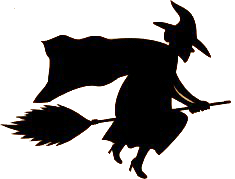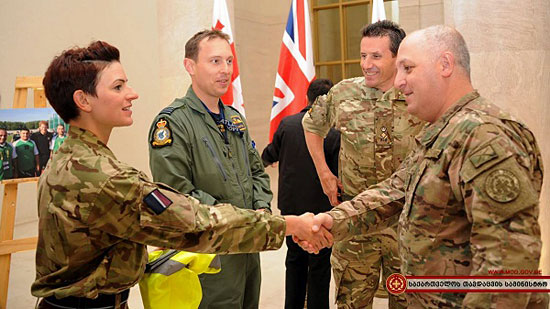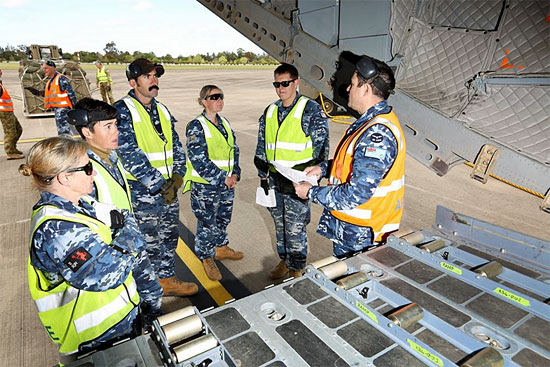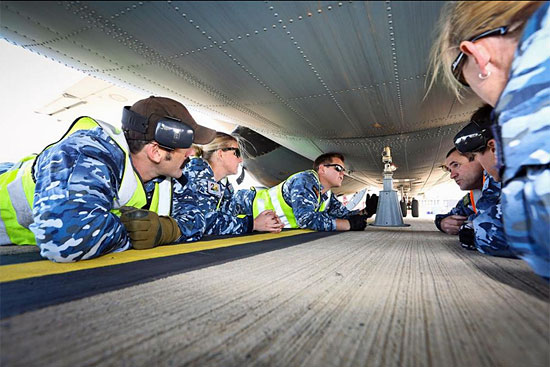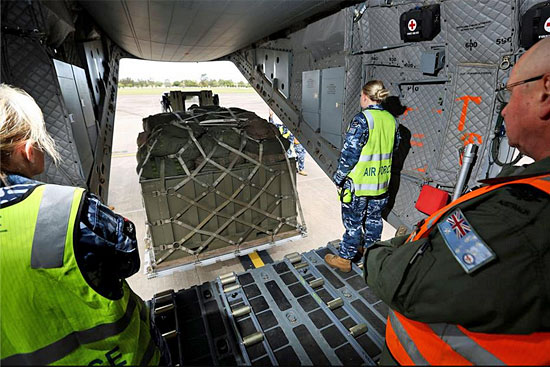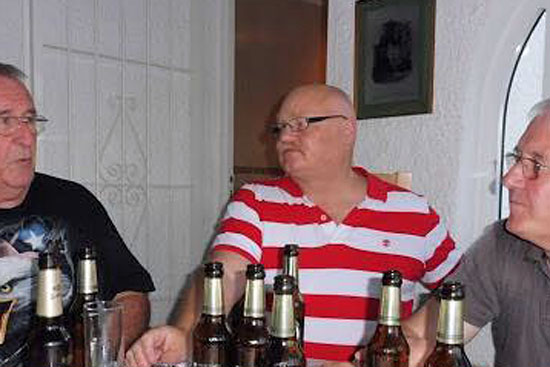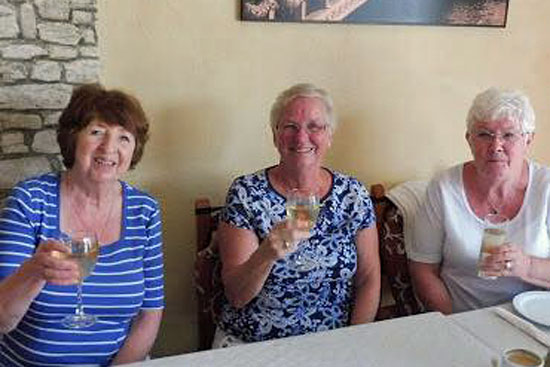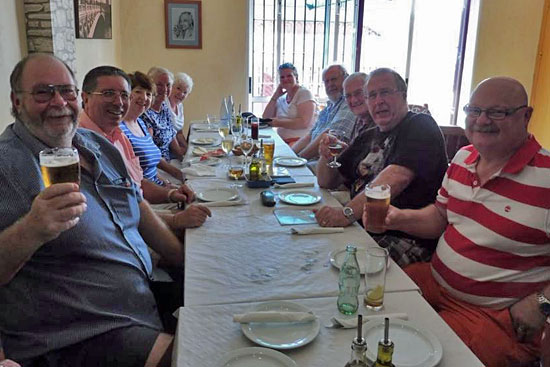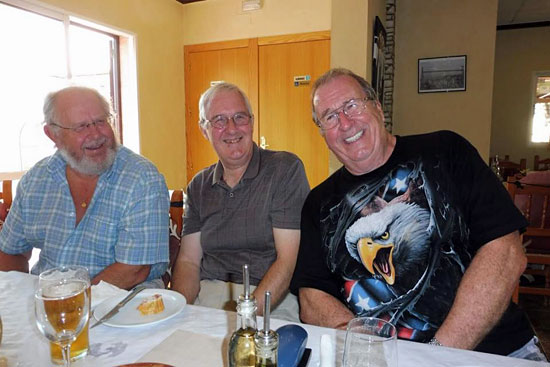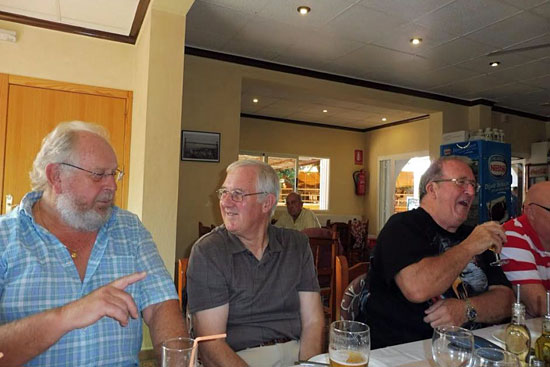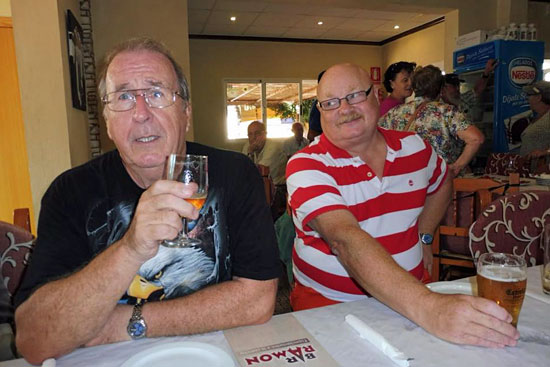Henry, Sea World's two-year-old polar bear, was a special passenger on a C-130J Hercules for the first leg of his relocation to Canada on October 6.
After his RAAF flight from the Gold Coast to Sydney, Henry departed for the Cochrane Polar Bear Habitat in Ontario as part of conservation efforts to support polar bear breeding following the decline of the wild population.
Hercules pilot, FLTLT Conan Brett, of No. 37 Squadron, said it was a fantastic opportunity to be able to combine routine flying operations with such a special event.
"It was a great honour for the RAAF to be able to assist with Henry's move," FLTLT Brett said. "I've flown thousands of passengers, but Henry is certainly the most unique." He said Henry was a 'cool' passenger.
After his RAAF flight from the Gold Coast to Sydney, Henry departed for the Cochrane Polar Bear Habitat in Ontario as part of conservation efforts to support polar bear breeding following the decline of the wild population.
Hercules pilot, FLTLT Conan Brett, of No. 37 Squadron, said it was a fantastic opportunity to be able to combine routine flying operations with such a special event.
"It was a great honour for the RAAF to be able to assist with Henry's move," FLTLT Brett said. "I've flown thousands of passengers, but Henry is certainly the most unique." He said Henry was a 'cool' passenger.

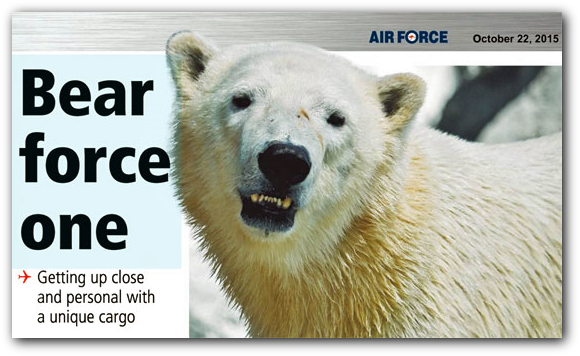
"Henry handled the flight very well and was calm throughout," FLTLT Brett said. "As an apex predator they have no ingrained fears and are more inquisitve than aggresive. It was however very reaassuring to have the custom-built cage to ensure he stayed where we wanted him."
Logistics officer FLGOFF Sarah Fraser, of the Air Mobility Control Centre, ensured Henry was loaded onto the aircraft safely. "Ensuring Henry's safety on the flight was a new experience and I was so excited to be able to use my skills to be able to transport him comfortably and securely," she said. "It can get quite cold at an altitude of 30,000 feet, so the conditions suited him well.
The Hercules crew met Henry and the Sea World team at his enclosure before the flight. "It was an amazing trip to be a part of and something that few people would have the opportunity to be involved in," FLTLT Brett said. "It was a 'feel good' mission because we were assisting Sea World and the wider conservation community by helping Henry on his way to, hopefully, integrate into the Canadian breeding program and support the survival of this beautiful animal."
[RAAF] Air Force News
Logistics officer FLGOFF Sarah Fraser, of the Air Mobility Control Centre, ensured Henry was loaded onto the aircraft safely. "Ensuring Henry's safety on the flight was a new experience and I was so excited to be able to use my skills to be able to transport him comfortably and securely," she said. "It can get quite cold at an altitude of 30,000 feet, so the conditions suited him well.
The Hercules crew met Henry and the Sea World team at his enclosure before the flight. "It was an amazing trip to be a part of and something that few people would have the opportunity to be involved in," FLTLT Brett said. "It was a 'feel good' mission because we were assisting Sea World and the wider conservation community by helping Henry on his way to, hopefully, integrate into the Canadian breeding program and support the survival of this beautiful animal."
[RAAF] Air Force News
From: Steve Harpum, Shrivenham, Oxon
Sent: 24 September 2015 18:18
Subject: Re: UKMAMS OBA OBB #092515
Many thanks for yet another excellent read, Tony - always a pleasure to see your name in the in-box.
Reading the various articles about brevets in this edition calls to mind the first of what turned out to be quite a few bollockings I received from OC UKMAMS when I was a team leader back in the early 80s.
Sent: 24 September 2015 18:18
Subject: Re: UKMAMS OBA OBB #092515
Many thanks for yet another excellent read, Tony - always a pleasure to see your name in the in-box.
Reading the various articles about brevets in this edition calls to mind the first of what turned out to be quite a few bollockings I received from OC UKMAMS when I was a team leader back in the early 80s.
Several of us bought old Met Observers brevets from a memorabilia stall at Fairford (yes, it was an 'M" with a single wing, for a short-lived aircrew trade before the tech negated the need for airborne met observers). We duly affixed these to our blue woolly-pullies and wore them into breakfast at Lyneham.
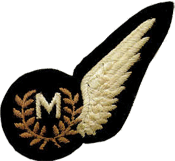
UK flies advanced military plane to Tbilisi
Needless to say, the various aircrew officers there were outraged to be informed that it was the new 'mover's brevet', and I seem to recall one or two spec aircrew Navs nearly having apoplexy. Much amusement for us, and I don't think Bob Dixon's heart was really in it when we were summoned to his office in due course either. Happy days! (I still have the brevet, framed with my Lockheed 1000 hours certificate, on the wall of the downstairs loo - where else?)
Best wishes to all,
Steve
Best wishes to all,
Steve
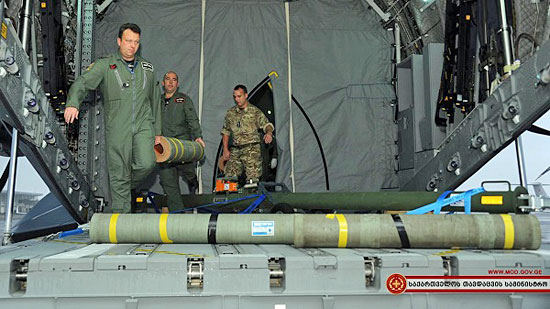
The Airbus A400M was launched in 2003 to respond to the combined needs of seven European nations: Belgium, France, Germany, Luxembourg, Spain, Turkey and the UK, with Malaysia later joining in 2005. The first aircraft's maiden flight took place on December 11, 2009.
Fitted with state-of-the-art technology, having this plane visit Georgia was a real coup. The plane landed on Tbilisi soil last night and a special ceremony was held today to deliver the sporting goods to the Georgian wounded soldiers.
Earlier today UK Defence Attaché for the South Caucasus, Lieutenant-Colonel Nick Wilkes, handed the sports gear to the Georgian side, noting he was happy to be in Georgia and praised the efforts and professionalism of the Georgian soldiers.
agenda.ge
Fitted with state-of-the-art technology, having this plane visit Georgia was a real coup. The plane landed on Tbilisi soil last night and a special ceremony was held today to deliver the sporting goods to the Georgian wounded soldiers.
Earlier today UK Defence Attaché for the South Caucasus, Lieutenant-Colonel Nick Wilkes, handed the sports gear to the Georgian side, noting he was happy to be in Georgia and praised the efforts and professionalism of the Georgian soldiers.
agenda.ge
The United Kingdom has delivered a special gift to Georgian soldiers wounded in battle via one of the most modern and technically advanced military planes in operation.
The soldiers, wounded in various international peacekeeping missions, gathered at Tbilisi Shota Rustaveli International Airport this morning and watched the British crew deliver sitting volleyball equipment to their Georgian partners.
The gear was transported from the UK by an Airbus A400M - one of the most unique and expensive aircrafts worldwide. Airbus has only created 14 such aircrafts, while 174 orders have been placed.
The plane is regarded as "the most versatile airlifter currently available” and can carry out many functions, ranging from mid-air refuelling to long range, high speed, low altitude flights. The plane has a capacity of 37 tonnes, meaning it can carry heavy and oversized loads previously unable to be transported by air.
The soldiers, wounded in various international peacekeeping missions, gathered at Tbilisi Shota Rustaveli International Airport this morning and watched the British crew deliver sitting volleyball equipment to their Georgian partners.
The gear was transported from the UK by an Airbus A400M - one of the most unique and expensive aircrafts worldwide. Airbus has only created 14 such aircrafts, while 174 orders have been placed.
The plane is regarded as "the most versatile airlifter currently available” and can carry out many functions, ranging from mid-air refuelling to long range, high speed, low altitude flights. The plane has a capacity of 37 tonnes, meaning it can carry heavy and oversized loads previously unable to be transported by air.
From: Rob Davies, Woodchurch, Kent
Sent: 25 September 2015 14:36
Subject: Re: UKMAMS OBA OBB #092515
Hi Tony,
I just saw your latest OBA newsletter. I was involved with the Spitfire meeting at Goodwood and was at the dinner at Goodwood House with many veterans and Prince Harry.
I flew the Mk.18 (Griffon powered) Spitfire over from the Hangar 10 Museum in Germany, for the Goodwood event. Also, the TR9 Spitfire was brought over from the same museum. Sadly, while I was moving the TR9 from Headcorn to Biggin Hill, it suffered engine failure and I had to belly it into a field. It is repairable and I was uninjured.
Two days later, I flew the Mk.18 up to Biggin, so I got back on the horse, so to speak.
Best
Rob
Sent: 25 September 2015 14:36
Subject: Re: UKMAMS OBA OBB #092515
Hi Tony,
I just saw your latest OBA newsletter. I was involved with the Spitfire meeting at Goodwood and was at the dinner at Goodwood House with many veterans and Prince Harry.
I flew the Mk.18 (Griffon powered) Spitfire over from the Hangar 10 Museum in Germany, for the Goodwood event. Also, the TR9 Spitfire was brought over from the same museum. Sadly, while I was moving the TR9 from Headcorn to Biggin Hill, it suffered engine failure and I had to belly it into a field. It is repairable and I was uninjured.
Two days later, I flew the Mk.18 up to Biggin, so I got back on the horse, so to speak.
Best
Rob
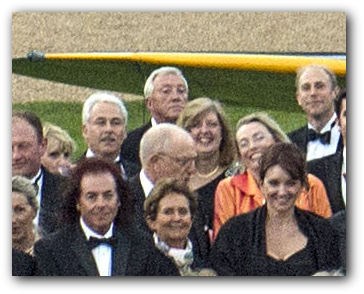
Rob is at top-centre
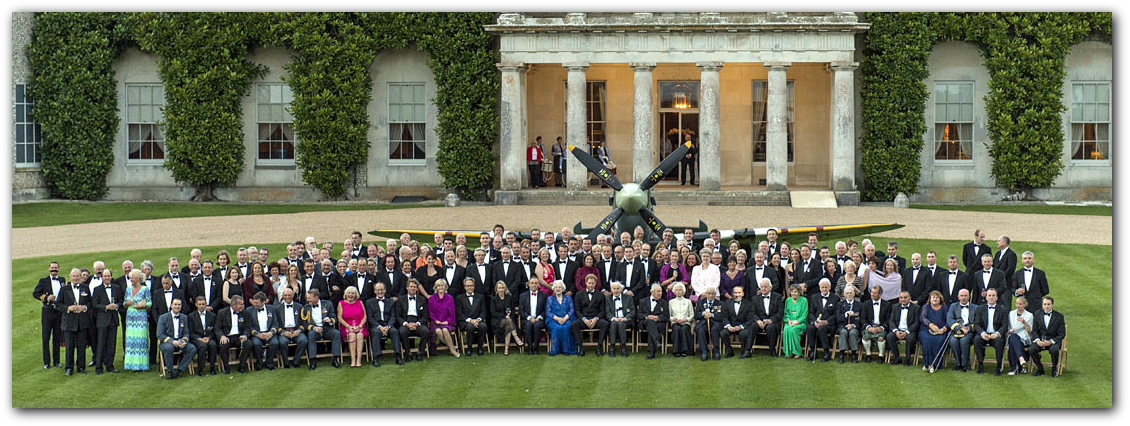
Spitfire pilot escapes with no injuries after crash landing in a field
just four years after surviving a crash in a different vintage plane
just four years after surviving a crash in a different vintage plane
• Rob Davies MBE crash landed his Spitfire plane in Kent field this morning
• Blames engine failure, which saw his power cut out while he was in mid air
• Plane badly damaged but renowned aircraft enthusiast left scene uninjured
• Crash comes four years after he collided with another plane while performing
in an airshow in Duxford - ejecting from 250ft
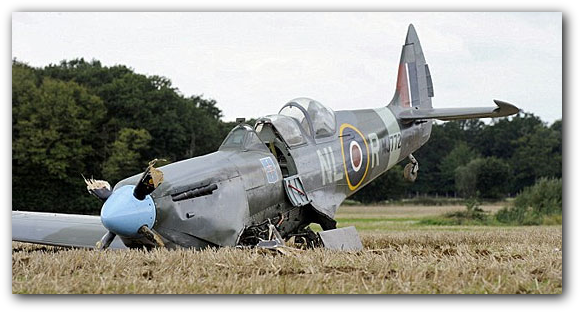
Well-known airman Rob Davies MBE walked away uninjured when the vintage plane he was flying crashed in Woodchurch, Kent, this morning. The 68-year-old careered through a grassy field before grinding to a halt after encountering engine failure while airborne. He managed to exit the aircraft without injury. However, the plane itself - a vintage Spitfire - will require restoring after suffering considerable damage. Mr Davies said, "I'm fine, it was a very simple engine failure, I walked away unscathed."
Today was the second time in four years the former RAF Air Movements Controller escaped with his life after falling from the sky. In 2011 he bailed out of a Second World War Mustang in mid-air after an airshow collision with another plane. His aircraft was clipped by a Sky Raider at the annual Flying Legends Airshow in Duxford, Cambridgeshire. As his plane plummeted to earth in a nose-dive, he ejected and managed to parachute to safety from just 250ft.
Today was the second time in four years the former RAF Air Movements Controller escaped with his life after falling from the sky. In 2011 he bailed out of a Second World War Mustang in mid-air after an airshow collision with another plane. His aircraft was clipped by a Sky Raider at the annual Flying Legends Airshow in Duxford, Cambridgeshire. As his plane plummeted to earth in a nose-dive, he ejected and managed to parachute to safety from just 250ft.
Mr Davies, was flying near his own landing strip at Woodchurch when the Spitfire suffered engine failure shortly after take-off this morning. Witnesses watched in horror as he downed and skidded across the grass, smashing the plane's front propeller.
Mr Davies had already managed to get out of the plane by the time the emergency services arrived. A South East Coast Ambulance Service spokeswoman said that an air ambulance, ambulance and heart unit were scrambled and the pilot was treated at the scene but did not need to be taken to hospital. She said, "A number of resources were sent to the scene but thankfully the pilot was not seriously injured. He only suffered minor injuries and was treated at the scene and was not taken to hospital."
Keen pilot Mr Davies is well known in vintage aircraft circles, having his own collection of historic aircraft which he often flies at air shows.
MailOnline
Mr Davies had already managed to get out of the plane by the time the emergency services arrived. A South East Coast Ambulance Service spokeswoman said that an air ambulance, ambulance and heart unit were scrambled and the pilot was treated at the scene but did not need to be taken to hospital. She said, "A number of resources were sent to the scene but thankfully the pilot was not seriously injured. He only suffered minor injuries and was treated at the scene and was not taken to hospital."
Keen pilot Mr Davies is well known in vintage aircraft circles, having his own collection of historic aircraft which he often flies at air shows.
MailOnline
Rumour has it...
It appears that Egypt has ordered the A400M Atlas airlifter. Earlier this month the Spanish publication Andalucia Informacion reported Pilar Albiac Murillo, Head of Operations and Transformation at Airbus, as saying that Egypt would like to have the A400M as soon as possible, but did not mention numbers or timeframe or if Egypt would buy aircraft off the production line or A400Ms surplus to Spanish requirements.
Egypt’s military is already an Airbus customer, having ordered 24 C295 light transport aircraft.
DefenceWeb
Egypt’s military is already an Airbus customer, having ordered 24 C295 light transport aircraft.
DefenceWeb
First C-27J Spartan Air Movements Course
Instructors from the RAAF School of Administration and Logistics Training (RAAF SALT) have taken students through the first C-27J Spartan Air Movements Course at RAAF Base Richmond.
The course is intended to provide students with the necessary training to conduct ground loading and related functions of the C-27J.
In RAAF service, the C-27J will be loaded with cargo and personnel from larger airfields. The aircraft will then fly these loads to airfields which cannot physically support larger transport aircraft.
Internally, the C-27J can accommodate up to three military pallets contaning cargo. Alternatively, it can be loaded with vehicles such as the G-Wagon or Land Rover 110.
The course is intended to provide students with the necessary training to conduct ground loading and related functions of the C-27J.
In RAAF service, the C-27J will be loaded with cargo and personnel from larger airfields. The aircraft will then fly these loads to airfields which cannot physically support larger transport aircraft.
Internally, the C-27J can accommodate up to three military pallets contaning cargo. Alternatively, it can be loaded with vehicles such as the G-Wagon or Land Rover 110.
[RAAF] Air Force News
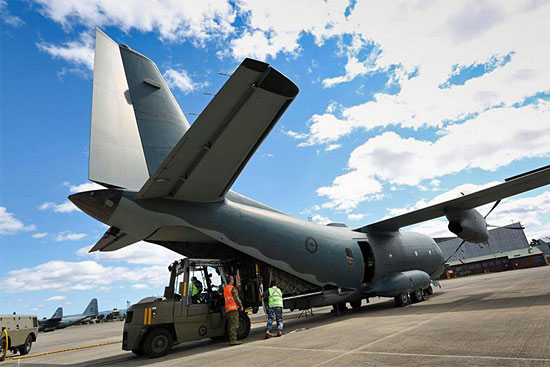
From: Bruce Oram, San Fulgencio, Alicante
Sent: 29 September 2015 6:36
Subject: Ex-Movers Meet on the Iberian Peninsula
Sent: 29 September 2015 6:36
Subject: Ex-Movers Meet on the Iberian Peninsula
Hi Tony,
I found out that Steve Perry was in my area for a few days after he phoned me and asked if we could meet up for a chat.
I contacted Syd Avery, Colin Menmuir, Jack Cross, Norm Stamper and they all decided to come along and surprise him. It tried to get Pete Cowan along, but unfortunately he had another engagement.
Cheers the noo
Bruce
I found out that Steve Perry was in my area for a few days after he phoned me and asked if we could meet up for a chat.
I contacted Syd Avery, Colin Menmuir, Jack Cross, Norm Stamper and they all decided to come along and surprise him. It tried to get Pete Cowan along, but unfortunately he had another engagement.
Cheers the noo
Bruce
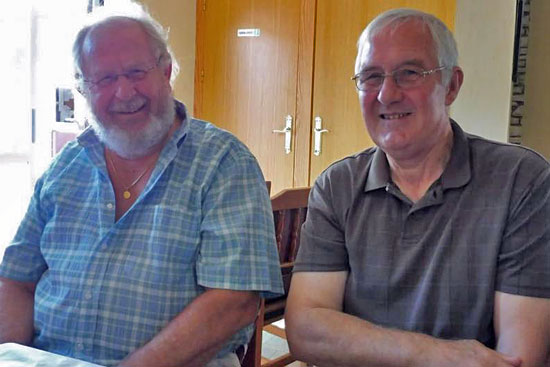
Who Dares Twins
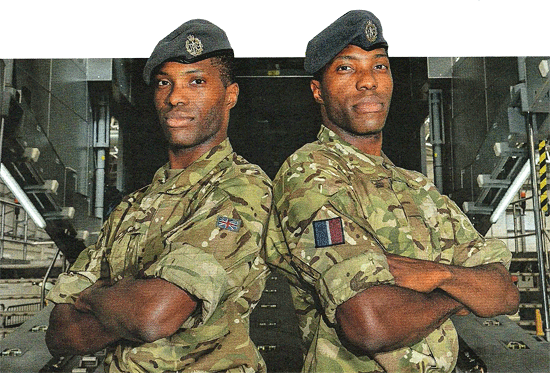
Identical twins Charles and Colin Ihe have passed their first milestone on their mission to dedicate their RAF careers to humanitarian work.
The brothers, who graduated from RAF Halton in May, recently graduated from the Air Movements School at RAF Brize Norton, after four months' classroom and practical training.
They are now looking forward to starting their six-month on-the-job conversion training as Leading Aircraftsmen on the Air Movements Squadron at Brize, before being posted to their first operational unit.
The twins, both International Relations graduates from London Metropolitan University, said they can't wait to get started.
Charles (the elder by six minutes) said, "This was always something we wanted to do. we have learned a lot, our course instructors have been fantastic.
The brothers, who graduated from RAF Halton in May, recently graduated from the Air Movements School at RAF Brize Norton, after four months' classroom and practical training.
They are now looking forward to starting their six-month on-the-job conversion training as Leading Aircraftsmen on the Air Movements Squadron at Brize, before being posted to their first operational unit.
The twins, both International Relations graduates from London Metropolitan University, said they can't wait to get started.
Charles (the elder by six minutes) said, "This was always something we wanted to do. we have learned a lot, our course instructors have been fantastic.
"They have made our transition so much easier. Now we are ready to put what we've learned into practice to help those in need around the world."
The brothers, who ran their own clothing and art business before they joined teh Air Force, emerged as the top students among the 16 on their course.
One of their trainers, Cpl David Windle, said, "Charles and Colin, with thier background in international development, have been really interesting to talk to. They have picked up everything we have taught them quickly and easily and put in every effort. They are probably the two best performing students I've had on this latest course."
The siblings, whose hometown is Chelmsford, said their ultimate ambition is to become RAF officers.
RAF News
The brothers, who ran their own clothing and art business before they joined teh Air Force, emerged as the top students among the 16 on their course.
One of their trainers, Cpl David Windle, said, "Charles and Colin, with thier background in international development, have been really interesting to talk to. They have picked up everything we have taught them quickly and easily and put in every effort. They are probably the two best performing students I've had on this latest course."
The siblings, whose hometown is Chelmsford, said their ultimate ambition is to become RAF officers.
RAF News
From: Keith Parker, Bowerhill, Wilts
Sent: 07 October 2015 10:47
Subject: Ivan and Wilma Gervais
Hi Tony
Yet again bad news I'm afraid. I'm sure that Ivan and Wilma Gervais were quite well known in the UKMAMS world. My son Scott was on a course recently given by a Mark Gervais. Scott recognized him immediately and after speaking with Mark he rang me with the sad news.
Both Ivan and Wilma have sadly passed away; all I know is that Ivan died about two years ago - no word on when Wilma passed. If anyone has words of condolence they can e-mail me and I will pass them on.
Keith
Sent: 07 October 2015 10:47
Subject: Ivan and Wilma Gervais
Hi Tony
Yet again bad news I'm afraid. I'm sure that Ivan and Wilma Gervais were quite well known in the UKMAMS world. My son Scott was on a course recently given by a Mark Gervais. Scott recognized him immediately and after speaking with Mark he rang me with the sad news.
Both Ivan and Wilma have sadly passed away; all I know is that Ivan died about two years ago - no word on when Wilma passed. If anyone has words of condolence they can e-mail me and I will pass them on.
Keith
50 Ways to Cancer-Proof Your Life Right Now
Cancer is the number one cause of death in the world. It causes absolute devastation physically, emotionally, and financially to patients and their families.
It also creates an economic backlash for nations struggling to maintain the rising cost of cancer care.
Scientists estimate that at least half of all cancer cases are preventable. According to the World Health Organization (WHO), there were 14 million new instances of cancer worldwide in 2012 and a shocking 8.2 million of those resulted in death.
Click on the image at left to download the .pdf document that just may save your life or that of a loved one.
It also creates an economic backlash for nations struggling to maintain the rising cost of cancer care.
Scientists estimate that at least half of all cancer cases are preventable. According to the World Health Organization (WHO), there were 14 million new instances of cancer worldwide in 2012 and a shocking 8.2 million of those resulted in death.
Click on the image at left to download the .pdf document that just may save your life or that of a loved one.
From: John Holloway, Shrewsbury
Sent: 13 October 2015 16:11
Subject: NSRAFA Cosford Branch
Hi Tony,
Our speaker today at Cosford gave us a really good talk on the Guy Fawkes plot in 1605. He kept our interest by the way he presented the story along with photos of the various properties of the conspirators all of which seem to be here in our area of the country.
The conspirators were all influential land owners who were all betrayed by a single letter to a chap named Robert Cecil who seemed to be just like our present day spy hunters. Its not known who wrote the letter which caused the demise of all the conspirators who were all executed in pretty gory ways.
Cheers
John
Sent: 13 October 2015 16:11
Subject: NSRAFA Cosford Branch
Hi Tony,
Our speaker today at Cosford gave us a really good talk on the Guy Fawkes plot in 1605. He kept our interest by the way he presented the story along with photos of the various properties of the conspirators all of which seem to be here in our area of the country.
The conspirators were all influential land owners who were all betrayed by a single letter to a chap named Robert Cecil who seemed to be just like our present day spy hunters. Its not known who wrote the letter which caused the demise of all the conspirators who were all executed in pretty gory ways.
Cheers
John
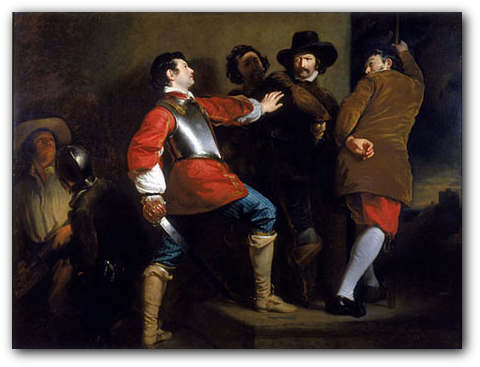
Airbus Eyes Opening Into U.S. Military Airlift Market
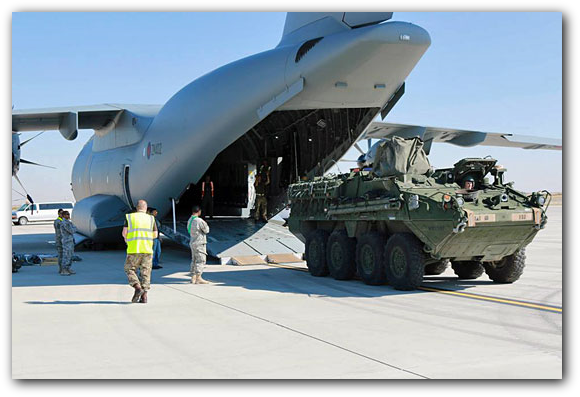
Army soldiers loaded a U.S. Stryker armored personnel carrier into a U.K. Royal Air Force A400M Atlas cargo aircraft during a recent equipment evaluation exercise. The vehicle rolled into the cargo compartment, was tied down as if it were being prepped to fly into combat and later unloaded.
RAF officials hailed the Stryker load and tie-down trial as a watershed event that kicks off the process for certifying that their A400M aircraft is capable of carrying U.S. combat vehicles into battle. To military commanders, the demonstration was a step toward greater interoperability between equipment from different NATO countries. To Airbus, it marked the “soft rollout” of its A400M tactical airlifter into a tough U.S. military market that is already owned by Boeing’s C-17 and Lockheed Martin’s C-130 cargo aircraft.
Airbus is positioning the A400M, not as a competitor to existing cargo planes, but as an aircraft that could fill gaps in the fleet. “It is a capability that does not exist today in the U.S. inventory,” said Allan McArtor, chairman and CEO of Airbus Group Inc.
RAF officials hailed the Stryker load and tie-down trial as a watershed event that kicks off the process for certifying that their A400M aircraft is capable of carrying U.S. combat vehicles into battle. To military commanders, the demonstration was a step toward greater interoperability between equipment from different NATO countries. To Airbus, it marked the “soft rollout” of its A400M tactical airlifter into a tough U.S. military market that is already owned by Boeing’s C-17 and Lockheed Martin’s C-130 cargo aircraft.
Airbus is positioning the A400M, not as a competitor to existing cargo planes, but as an aircraft that could fill gaps in the fleet. “It is a capability that does not exist today in the U.S. inventory,” said Allan McArtor, chairman and CEO of Airbus Group Inc.
McArtor is well aware of the political obstacles of selling a European plane to the Defense Department, a challenge that Airbus lost five years ago when it competed for a contract to supply refueling tankers to the U.S. Air Force.
Airbus executives have been marketing the A400M at the Pentagon for some time, pointing out that it can carry heavier loads than the C-130 and can land where a C-17 can’t. “It fits into a very attractive niche,” McArtor told National Defense in an interview. “It’s an important missing piece for U.S. airlift.”
The aircraft is not yet ready for prime time. It is still experiencing growing pains and recovering from the fallout of a deadly crash in Spain last year, but the company is taking the long view.
“Given some time I think we’ll have a very competitive airplane,” said McArtor. The A400M also is being proposed as a refueling tanker that could land in unprepared strips. Airbus executives have computer models that show that the availability of an A400M refueling tanker would allow U.S. and NATO forces more flexibility to operate on islands where there may not be big enough airfields to land conventional tankers.
“We still have a lot of work to do to mature the airplane,” said McArtor. There are still software glitches that are being fixed, not an uncommon problem in new aircraft. “It’s a little early for us to have a very aggressive campaign, but it will come,” he added. “We have a continuing dialogue with the air staff. They talk to their counterparts in the U.K. and other nations that have it. [Air Force Chief of Staff] Gen. Mark Welsh has been in the airplane twice.”
Airbus executives have been marketing the A400M at the Pentagon for some time, pointing out that it can carry heavier loads than the C-130 and can land where a C-17 can’t. “It fits into a very attractive niche,” McArtor told National Defense in an interview. “It’s an important missing piece for U.S. airlift.”
The aircraft is not yet ready for prime time. It is still experiencing growing pains and recovering from the fallout of a deadly crash in Spain last year, but the company is taking the long view.
“Given some time I think we’ll have a very competitive airplane,” said McArtor. The A400M also is being proposed as a refueling tanker that could land in unprepared strips. Airbus executives have computer models that show that the availability of an A400M refueling tanker would allow U.S. and NATO forces more flexibility to operate on islands where there may not be big enough airfields to land conventional tankers.
“We still have a lot of work to do to mature the airplane,” said McArtor. There are still software glitches that are being fixed, not an uncommon problem in new aircraft. “It’s a little early for us to have a very aggressive campaign, but it will come,” he added. “We have a continuing dialogue with the air staff. They talk to their counterparts in the U.K. and other nations that have it. [Air Force Chief of Staff] Gen. Mark Welsh has been in the airplane twice.”
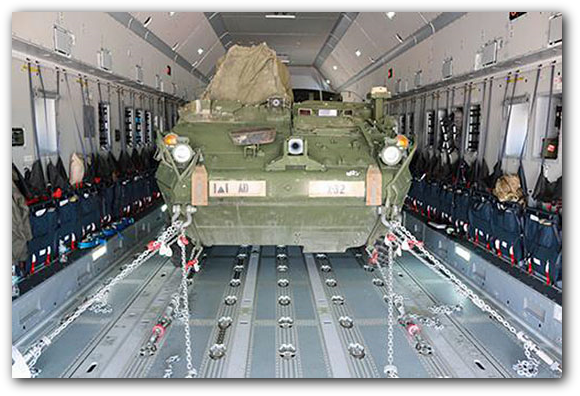
While there are no plans today to build the A400M in the United States, McArtor said the company would consider producing the aircraft in Mobile, Alabama, where it recently opened a commercial airliner assembly plant.
A central player in deciding what cargo planes the Pentagon buys is the Army, which makes the Stryker demonstration - conducted in late September at Fort Bliss, Texas - all the more noteworthy. “We have to demonstrate the airplane in a tactical setting,” said McArtor. The test at Fort Bliss is just a “data point in building confidence in the airplane.”
The commander of the Royal Air Force 70 Squadron that plans to operate the A400, Wing Commander Simon Boyle, said he was excited to work with the U.S. Army at a time when NATO countries worry about security challenges in Europe. The Stryker trial has “significant implications for future NATO and U.K./U.S. interoperability as the loading exercise links directly to the vehicle’s certification for carriage in the A400M,” he said in a RAF news release.
A central player in deciding what cargo planes the Pentagon buys is the Army, which makes the Stryker demonstration - conducted in late September at Fort Bliss, Texas - all the more noteworthy. “We have to demonstrate the airplane in a tactical setting,” said McArtor. The test at Fort Bliss is just a “data point in building confidence in the airplane.”
The commander of the Royal Air Force 70 Squadron that plans to operate the A400, Wing Commander Simon Boyle, said he was excited to work with the U.S. Army at a time when NATO countries worry about security challenges in Europe. The Stryker trial has “significant implications for future NATO and U.K./U.S. interoperability as the loading exercise links directly to the vehicle’s certification for carriage in the A400M,” he said in a RAF news release.
At the NATO 2014 Wales summit, leaders agreed to establish a rapid-response force able to deploy on short notice. The Stryker vehicle is one of the primary combat platforms of the U.S. Army 2nd Cavalry Regiment in Vilseck, Germany.
“With interoperability at the heart of the A400M program, the opportunity to load a core fighting vehicle of the U.S. Army into a RAF A400M has provided a clear demonstration of the aircraft’s utility in the coalition operating environment,” Boyle noted.
The U.K. team worked with A Company 4th Battalion 17th Infantry Regiment 1st Brigade 1st Armored Division at Fort Bliss to load, tie down and unload a Stryker infantry combat vehicle variant. The data from the test will be used to seek air transportation certification for the Stryker in the A400M.
The RAF recently accepted the eighth of the 22 aircraft that it has ordered, with a goal of declaring the fleet operational by 2017. The A400 was initially conceived as a replacement to the C-130K that would work alongside the C-130J fleet. But the Ministry of Defence decided in 2010 to retire the Hercules by 2022 and make the Atlas the United Kingdom’s principal tactical airlifter.
“In terms of physical size, the aircraft sits almost midway between the C-17 and C-130J although because its wingspan is only about 2 meters wider than a C-130J, it has a very similar ground footprint,” Air Commander David Lee, assistant chief of staff for air capability, air mobility and air enablers, told an industry conference in September.
With regard to speed and range, he said, the A400M is closer to a C-17 than to the C-130J. The size and shape of the cargo bay is a significant feature, Lee added. “Of the equipment declared to be air transportable by Defence, Atlas meets 80 percent whereas the C-130J can only carry 29 percent.”
The Stryker vehicle used in the Fort Bliss test - part of a broader Army equipment demonstration called “network integration evaluation” - weighed around 36,000 pounds.
“With interoperability at the heart of the A400M program, the opportunity to load a core fighting vehicle of the U.S. Army into a RAF A400M has provided a clear demonstration of the aircraft’s utility in the coalition operating environment,” Boyle noted.
The U.K. team worked with A Company 4th Battalion 17th Infantry Regiment 1st Brigade 1st Armored Division at Fort Bliss to load, tie down and unload a Stryker infantry combat vehicle variant. The data from the test will be used to seek air transportation certification for the Stryker in the A400M.
The RAF recently accepted the eighth of the 22 aircraft that it has ordered, with a goal of declaring the fleet operational by 2017. The A400 was initially conceived as a replacement to the C-130K that would work alongside the C-130J fleet. But the Ministry of Defence decided in 2010 to retire the Hercules by 2022 and make the Atlas the United Kingdom’s principal tactical airlifter.
“In terms of physical size, the aircraft sits almost midway between the C-17 and C-130J although because its wingspan is only about 2 meters wider than a C-130J, it has a very similar ground footprint,” Air Commander David Lee, assistant chief of staff for air capability, air mobility and air enablers, told an industry conference in September.
With regard to speed and range, he said, the A400M is closer to a C-17 than to the C-130J. The size and shape of the cargo bay is a significant feature, Lee added. “Of the equipment declared to be air transportable by Defence, Atlas meets 80 percent whereas the C-130J can only carry 29 percent.”
The Stryker vehicle used in the Fort Bliss test - part of a broader Army equipment demonstration called “network integration evaluation” - weighed around 36,000 pounds.
The Air Force has transported Stryker vehicles in C-130s without slat armor, but it did not provide clearances on the sides as required by regulation and could not land on a dirt strip with an eight-person crew. Airbus officials said the A400M would be able to transport a 9-foot wide Stryker with the slat armor, although one side would have to be installed after landing.
According to company marketing materials, the A400M cargo box size is 3 feet wider and 3.5 feet taller than the C-130 and can carry a much bigger tactical load, or about 66,000 pounds. Air Force fact sheets indicate the maximum load for the C-130J-30 is 36,000 pounds.
According to company marketing materials, the A400M cargo box size is 3 feet wider and 3.5 feet taller than the C-130 and can carry a much bigger tactical load, or about 66,000 pounds. Air Force fact sheets indicate the maximum load for the C-130J-30 is 36,000 pounds.
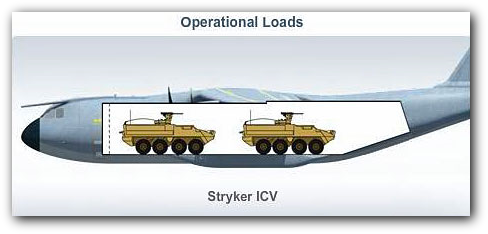
The C-130J-30 is known as the “stretch” model - it is 15 feet longer than the conventional version - and makes up a majority of combat C-130Js that are being delivered, said Lockheed Martin spokeswoman Stephanie Sonnenfeld Stinn. The company is “constantly evaluating the needs of our customer and works to meet those needs to the maximum extent possible,” she told National Defense in a statement.
Airbus officials insist they are not seeking to displace the C-130 but rather fill demands that the Hercules can’t meet. More than 60 nations operate the C-130 and Lockheed so far has delivered more than 2,300 aircraft since 1956.
Meanwhile, eight countries have placed orders for 174 A400M aircraft and so far have received 16. Buyers include Belgium (seven), France (50), Germany (53), Luxemburg (one), Spain (27), Turkey (10), the United Kingdom (22) and Malaysia (four).
U.S. industry insiders have been skeptical about the A400M’s chances in the United States. “The C-130 has been around since the Vietnam War and has been a very capable aircraft,” said Air Force veteran and former C-130 pilot Steve Griffin. “It has met the Army’s needs for intra-theater lift.” But he does not discount the possibility that the Army may one day push for the acquisition of the A400M. “They would like it because it’s a turboprop.”
Griffin said he would expect Lockheed Martin to make whatever modifications were needed in the C-130 to keep the A400M from encroaching in its market. “If the Army says they need to transport a heavier Stryker, I think Lockheed will make that happen.”
Stephen D. Mundt, a retired Army brigadier general and now senior vice president of Airbus, has been pleading his case to Air Force leaders. “We need something to move supplies in austere theaters,” he told National Defense during an industry conference earlier this year.
“The C-130 is a great tactical aircraft to bring people and pallets. But if you want to bring tactical vehicles, it doesn’t do that. The C-17 will do that, but it won’t land at the point of employment. What tactical vehicles can you put in a C-130?”
National Defense Industrial Association
Airbus officials insist they are not seeking to displace the C-130 but rather fill demands that the Hercules can’t meet. More than 60 nations operate the C-130 and Lockheed so far has delivered more than 2,300 aircraft since 1956.
Meanwhile, eight countries have placed orders for 174 A400M aircraft and so far have received 16. Buyers include Belgium (seven), France (50), Germany (53), Luxemburg (one), Spain (27), Turkey (10), the United Kingdom (22) and Malaysia (four).
U.S. industry insiders have been skeptical about the A400M’s chances in the United States. “The C-130 has been around since the Vietnam War and has been a very capable aircraft,” said Air Force veteran and former C-130 pilot Steve Griffin. “It has met the Army’s needs for intra-theater lift.” But he does not discount the possibility that the Army may one day push for the acquisition of the A400M. “They would like it because it’s a turboprop.”
Griffin said he would expect Lockheed Martin to make whatever modifications were needed in the C-130 to keep the A400M from encroaching in its market. “If the Army says they need to transport a heavier Stryker, I think Lockheed will make that happen.”
Stephen D. Mundt, a retired Army brigadier general and now senior vice president of Airbus, has been pleading his case to Air Force leaders. “We need something to move supplies in austere theaters,” he told National Defense during an industry conference earlier this year.
“The C-130 is a great tactical aircraft to bring people and pallets. But if you want to bring tactical vehicles, it doesn’t do that. The C-17 will do that, but it won’t land at the point of employment. What tactical vehicles can you put in a C-130?”
National Defense Industrial Association
From: Steve Harpum, Shrivenham, Oxon
Sent: 16 October 2015 12:58
Subject: Re: The next OBA newsletter - Exotic or Strange Loads
I know you're not talking about the ladies of the night, but you have reminded me of the time in Belize when I was OC Movs in the early 80's and one of the Movers asked to be excused from the weekly C130 turn-round for 10 minutes as he had a 'dose' and had to tell his recent partners that they needed to get tested.
Permission being duly given he wandered off to the side of the pan as a tatty old American car came up the road. Next thing we knew he was running for cover while being attacked by half a dozen ladies from Raoul's Rose garden!
Have a good one,
Steve
Sent: 16 October 2015 12:58
Subject: Re: The next OBA newsletter - Exotic or Strange Loads
I know you're not talking about the ladies of the night, but you have reminded me of the time in Belize when I was OC Movs in the early 80's and one of the Movers asked to be excused from the weekly C130 turn-round for 10 minutes as he had a 'dose' and had to tell his recent partners that they needed to get tested.
Permission being duly given he wandered off to the side of the pan as a tatty old American car came up the road. Next thing we knew he was running for cover while being attacked by half a dozen ladies from Raoul's Rose garden!
Have a good one,
Steve
Hercules aircraft turns 50
A fleet of Hercules aircraft used by the Royal New Zealand Air Force is marking half a century of missions around the Pacific region. The C-130 aircraft is largely used for delivering aid, but has also played a part in search and rescue missions and transporting troops.
In March this year, the first of the fleet, NZ7001 tipped off the year-long celebration flying out of Whenuapai with aid for Tuvalu, before returning to Suva for the night. That aircraft has been based at Whenuapai since 1965. Now, the rest of the five-piece fleet are all reaching the milestone and taking to the air to celebrate.
Chief of Air Force Air Vice-Marshal, Mike Yardley says the fleet is one of RNZAF's busiest. "The C-130 is one of our busiest fleets because of the variety of taskings it can complete.
"For example, this summer season we have flown four missions to Antarctica to support Antarctica New Zealand and we recently delivered two large electricity generators to Mauke in the Cook Islands."
In March this year, the first of the fleet, NZ7001 tipped off the year-long celebration flying out of Whenuapai with aid for Tuvalu, before returning to Suva for the night. That aircraft has been based at Whenuapai since 1965. Now, the rest of the five-piece fleet are all reaching the milestone and taking to the air to celebrate.
Chief of Air Force Air Vice-Marshal, Mike Yardley says the fleet is one of RNZAF's busiest. "The C-130 is one of our busiest fleets because of the variety of taskings it can complete.
"For example, this summer season we have flown four missions to Antarctica to support Antarctica New Zealand and we recently delivered two large electricity generators to Mauke in the Cook Islands."
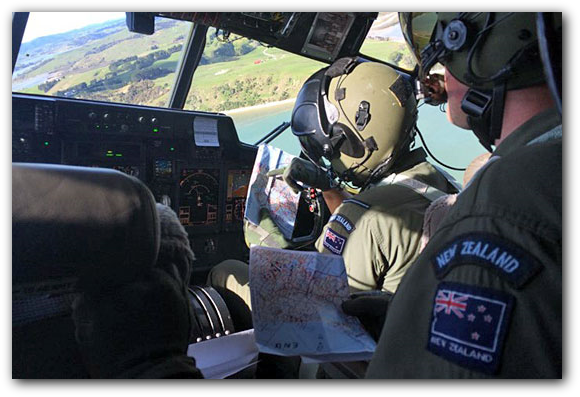
Despite the age of the C-130, it has been constantly upgraded throughout the years by a Life Extension Upgrade project run out of the RNZAF base in Blenheim. All aspects of the aircraft including mechanical and structural components have been looked over, along with updates to the navigation systems.
New Zealand is one of 60 nations still using the C-130 aircraft; it holds the record for the longest continuous production of any military aircraft.
3news.co.nz
New Zealand is one of 60 nations still using the C-130 aircraft; it holds the record for the longest continuous production of any military aircraft.
3news.co.nz
A new member joining us recently is:

RAF
Ian Hambleton, Blackpool. Lancashire, United Kingdom
Welcome to the OBA!
Date: 10/17/2015, 9:55 am, EDT
Name: David Trotter (mrdavidtrotter@yahoo.co.uk)
Subject: Guest Book Entry
Hi, nice website. On your RAF Khormaksar page, you have an extract from The Dhow which you date from 1967. The same extract is on Alan Liptrot's contribution to Old Bods Briefs, dated 1966 or 1967. !966 must be the correct year.
The Limmer and Trinidad employee fatally shot in Shuqra was called Mike, with a surname that sounded like "Treppis" (I can't remember the spelling). His colleague on the site, though not present at the shooting, was my late father, Robert Trotter.
I remember that Limmer were very pleased with my father for, among other things, continuing to work there after the shooting. He left Aden in the second half of 1966.
I think that Mike cannot have died instantly, as it became known that the Arab guards provided by the local sheikh disappeared shortly before the shooting. My father said that the sheikh afterwards took members of the guards' families hostage to guarantee their co-operation until Limmer's work was completed. Sadly, hostage taking seems to have been a common practice up country in those days, and even archaeological expeditions used to travel with hostages for security.
Name: David Trotter (mrdavidtrotter@yahoo.co.uk)
Subject: Guest Book Entry
Hi, nice website. On your RAF Khormaksar page, you have an extract from The Dhow which you date from 1967. The same extract is on Alan Liptrot's contribution to Old Bods Briefs, dated 1966 or 1967. !966 must be the correct year.
The Limmer and Trinidad employee fatally shot in Shuqra was called Mike, with a surname that sounded like "Treppis" (I can't remember the spelling). His colleague on the site, though not present at the shooting, was my late father, Robert Trotter.
I remember that Limmer were very pleased with my father for, among other things, continuing to work there after the shooting. He left Aden in the second half of 1966.
I think that Mike cannot have died instantly, as it became known that the Arab guards provided by the local sheikh disappeared shortly before the shooting. My father said that the sheikh afterwards took members of the guards' families hostage to guarantee their co-operation until Limmer's work was completed. Sadly, hostage taking seems to have been a common practice up country in those days, and even archaeological expeditions used to travel with hostages for security.
RAF Brize Norton Wowed By Impromptu Tongan 'Sipi Tau'
The Tongan Defence Force has caused quite a stir by performing the nation's 'Sipi Tau' after stepping out onto RAF Brize Norton.
They made the long journey in order to take part in the 2015 International Defence Rugby Competition and they hope their performance of the 'Sipi Tau' has shown their opponents they mean business.
Tonga's manager, Commander Sione Lino, told Forces TV the team had performed the war dance after they were surprised by a visit from the Tongan ambassador upon arrival.
They made the long journey in order to take part in the 2015 International Defence Rugby Competition and they hope their performance of the 'Sipi Tau' has shown their opponents they mean business.
Tonga's manager, Commander Sione Lino, told Forces TV the team had performed the war dance after they were surprised by a visit from the Tongan ambassador upon arrival.
Tug Wilson/Forces TV
From: Wayne Donner, Medicine Hat, AB
Sent: 23 October 2015 13:33
Subject: Exotic or Strange Loads
When I was a loadie with 447 SQN Chinooks in Edmonton, we were tasked to go to CFB Cold Lake to pick up cargo from a Herc that was from Queens’ University in Kingston and deliver it to CFB Suffield where it was to be destroyed.
When we got to Cold Lake this item was in three different inner metal containers and an outer a metal garbage can. There was an escort with this cargo, a Lieutenant Colonel. A medical person was going with us so he asked the Colonel what the antidote was (then he could find out what the mysterious load was) but the escort said that he had the antidote with him.
I put a parachute on the load in case we had to get rid of it in a hurry. By this time it was so foggy you could hardly see in front of you but the pilot said this is an urgent operational necessity and, instead of hovering as usual, we took off down the runway, lifted off and at around 700 feet it was clear weather.
After we landed in Suffield and unloaded our cargo we never did find out what it was. (I suspect it was a chemical experiment done at the university which had to be destroyed at Suffield.)
Wayne Donner
Sent: 23 October 2015 13:33
Subject: Exotic or Strange Loads
When I was a loadie with 447 SQN Chinooks in Edmonton, we were tasked to go to CFB Cold Lake to pick up cargo from a Herc that was from Queens’ University in Kingston and deliver it to CFB Suffield where it was to be destroyed.
When we got to Cold Lake this item was in three different inner metal containers and an outer a metal garbage can. There was an escort with this cargo, a Lieutenant Colonel. A medical person was going with us so he asked the Colonel what the antidote was (then he could find out what the mysterious load was) but the escort said that he had the antidote with him.
I put a parachute on the load in case we had to get rid of it in a hurry. By this time it was so foggy you could hardly see in front of you but the pilot said this is an urgent operational necessity and, instead of hovering as usual, we took off down the runway, lifted off and at around 700 feet it was clear weather.
After we landed in Suffield and unloaded our cargo we never did find out what it was. (I suspect it was a chemical experiment done at the university which had to be destroyed at Suffield.)
Wayne Donner
C-27J Spartan Cargo Interoperability Trial
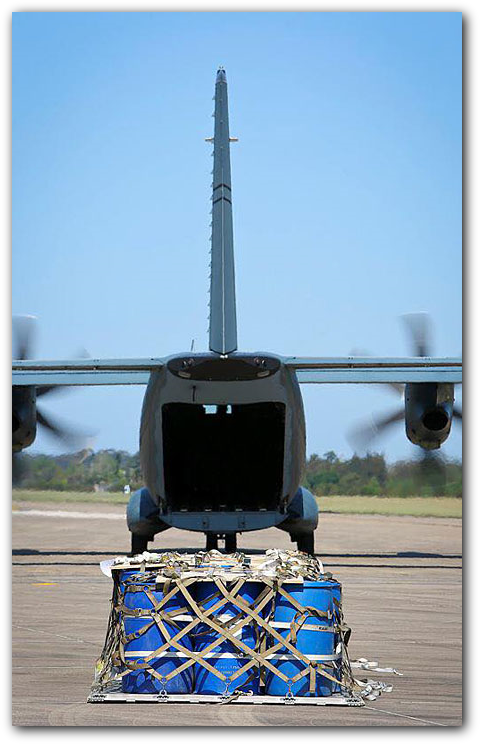
Earlier this month, a cargo interoperability trial was conducted between a C-130J Hercules and C-27J Spartan at RAAF Base Richmond, with Air Movements personnel transferring pallets from one aircraft to another.
The cargo bay dimensions of the C-27J Spartan allow it to carry many payloads that are already carried by other Australian Defence Force aircraft.
The C-27J, however, can operate from airfields that are too small or soft for larger Air Force transport aircraft, or out of the range of Army rotary-wing transports.
Compatibility of these payloads means that larger transports can carry bulk amounts of cargo to a base or airport, where the cargo is then loaded onto the C-27J for the journey to a forward operating base or other frontline location.
Air Force is introducing a fleet of 10 C-27J Spartans into service with No. 35 Squadron.
The cargo bay dimensions of the C-27J Spartan allow it to carry many payloads that are already carried by other Australian Defence Force aircraft.
The C-27J, however, can operate from airfields that are too small or soft for larger Air Force transport aircraft, or out of the range of Army rotary-wing transports.
Compatibility of these payloads means that larger transports can carry bulk amounts of cargo to a base or airport, where the cargo is then loaded onto the C-27J for the journey to a forward operating base or other frontline location.
Air Force is introducing a fleet of 10 C-27J Spartans into service with No. 35 Squadron.
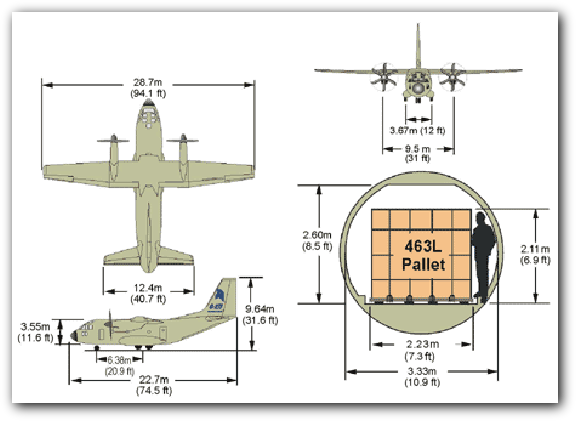
ForceNet Community
From: Meirion Jones, Barry, Vale of Glamorgan
Sent: 23 October 2015 15:48
Subject: Exotic or Strange Loads
Hi Tony,
Whilst browsing through the OBA photo album 1970 Page 1 (not a lot on the box that night) I spotted a picture of Flt Lt MacKenze disappearing into a Belfast driving a Blaw-Knox tarmac layer.
At this time Concorde was undergoing flight tests down in Singapore, and the runway surface ripples were rattling the pilot's fillings during take off and landing runs, to say nothing regarding the tall slender nose oleo. So an urgent re-surface was called for.
The Blaw-Knox proved to be a right pain to secure due to its high weight with not a lot of obvious attachment points, despite all those wheels.
We (the loading team) did not accompany the load for reasons that are lost in the sands of time; however, Flt LT MacKenze was accompanied by someone from static (to give him mobile experience). This person did not have a KD tropical uniform, so since he was of my height and build Pat volunteered me to hand over mine. Oh well, you cant win them all!
Sent: 23 October 2015 15:48
Subject: Exotic or Strange Loads
Hi Tony,
Whilst browsing through the OBA photo album 1970 Page 1 (not a lot on the box that night) I spotted a picture of Flt Lt MacKenze disappearing into a Belfast driving a Blaw-Knox tarmac layer.
At this time Concorde was undergoing flight tests down in Singapore, and the runway surface ripples were rattling the pilot's fillings during take off and landing runs, to say nothing regarding the tall slender nose oleo. So an urgent re-surface was called for.
The Blaw-Knox proved to be a right pain to secure due to its high weight with not a lot of obvious attachment points, despite all those wheels.
We (the loading team) did not accompany the load for reasons that are lost in the sands of time; however, Flt LT MacKenze was accompanied by someone from static (to give him mobile experience). This person did not have a KD tropical uniform, so since he was of my height and build Pat volunteered me to hand over mine. Oh well, you cant win them all!
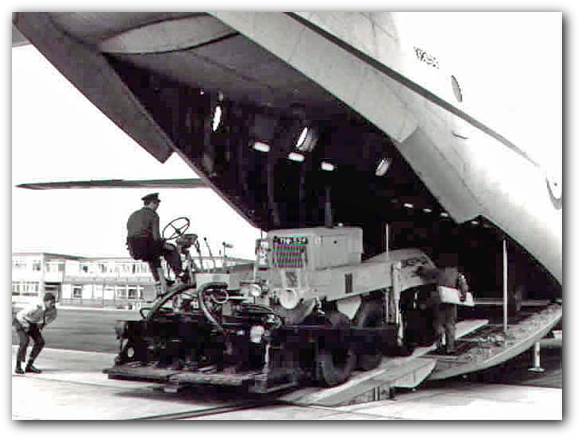
Another contender for strange (but probably should be filed under large) load occurred on the 23 March 1976. Belfast tail 364 Brize to Pisa; load 155mm FH70 self-propelled gun. Apparently this item had not been flown before so JATE would be inspecting the tiedown before we could depart. All seemed straightforward, plenty of chunky attachment points, no problems, well, until the JATE team arrived. They ummed and ahhed over most of the angles, and I well remember a Parachute Regiment Officer objecting to almost everything (there's me thinking they were only interested in jumping out of serviceable aircraft). Eventually it was passed without a chain being moved, and off we went.
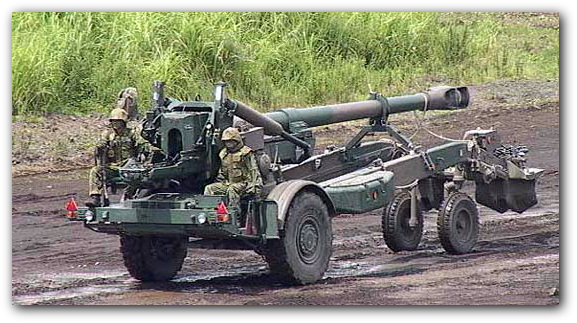
On arrival at Pisa , Cliff Weeks and myself were standing either side of the ramp, ready to install the support struts once the ramp was lowered, (nothing happened very quickly on the Belfast) so by this time it was down to horizontal and the Italians were already reversing a wooden floor lorry of questionable vintage towards us.
We took one look at each other and decided to wave them away. There followed an arm waving contest. Two civilian Italian lorry drivers wanted the ramp level to offload directly on to the lorry, whilst we wanted the ramp down and the gun on the apron.
Since it was 6 Brits against 2 Italians the gun ended up on the apron and we closed up eager to depart only for a USAF C-130 to arrive and park in front of us, trapping us in. So we were obliged to wait whilst they did their thing.
We took one look at each other and decided to wave them away. There followed an arm waving contest. Two civilian Italian lorry drivers wanted the ramp level to offload directly on to the lorry, whilst we wanted the ramp down and the gun on the apron.
Since it was 6 Brits against 2 Italians the gun ended up on the apron and we closed up eager to depart only for a USAF C-130 to arrive and park in front of us, trapping us in. So we were obliged to wait whilst they did their thing.
Since it was a warm afternoon we elected to take our lunch boxes out on to the grass, and then the fun really began. It did not take a brain surgeon to work out that this lorry was not up to the job, but our arm waving friends were not deterred. The gun was driven muzzle first on to the lorry until said muzzle made contact with the cab, whilst the main wheels were hardly onto their flimsy ramp. Lots of arm waving, and off it came, turn around and reverse it up main wheels first.
The inevitable was bound to happen; as soon as the main wheels (breach end) arrived on the flat bed down went the back, up in to the air went the cab, now the arm waving became really serious. Regrettably at this point the USAF C-130 moved off and so we departed without witnessing the conclusion to this farce.
The inevitable was bound to happen; as soon as the main wheels (breach end) arrived on the flat bed down went the back, up in to the air went the cab, now the arm waving became really serious. Regrettably at this point the USAF C-130 moved off and so we departed without witnessing the conclusion to this farce.
On the return flight we were traveling just above a layer of flattish cloud which gave the impression of some speed - in a Belfast! (affectionately known as the Slug) and then it got even better as the sun went down and turned the cloud and sky in to an amazing kaleidoscope of colour.
What an amazing day:
1) Educational: Insight into the workings of JATE
2) Entertaining: Italian arm waving
3) Wonder: The colours of the natural world
What more could a young man ask for, and all this whilst receiving the odd shilling from Her Majesty.
Best Regards,
Meirion (Taff) Jones
What an amazing day:
1) Educational: Insight into the workings of JATE
2) Entertaining: Italian arm waving
3) Wonder: The colours of the natural world
What more could a young man ask for, and all this whilst receiving the odd shilling from Her Majesty.
Best Regards,
Meirion (Taff) Jones
RAF A400M makes Seoul debut
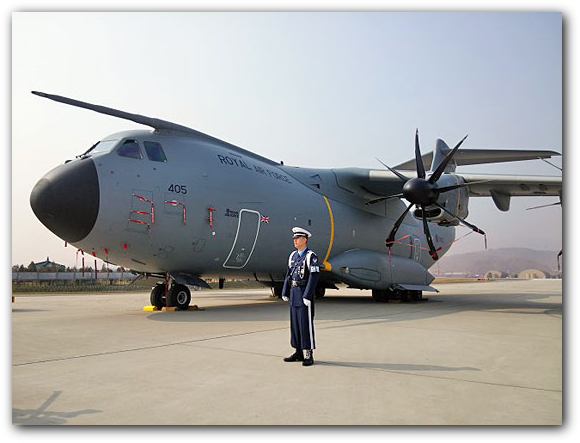
A UK Royal Air Force Airbus Defence & Space A400M was the star of this year’s Seoul International Aerospace & Defense Exhibition (ADEX).
Aircraft ZM405 is the fourth aircraft delivered to the RAF and appeared in the show’s static display. Its stop is part of a round-the-world trip, which has seen the "Atlas" visit Tbilisi in Georgia, the United Arab Emirates and Malaysia prior to arriving in South Korea.
Subsequently, it will travel to Japan, Hawaii, California, and Canada before returning to its base at RAF Brize Norton in Oxfordshire. The aircraft is carrying 32 personnel on the trip, including the RAF Falcons parachute display team.
Speaking to Flightglobal aboard the aircraft, Airbus Defence & Space regional director for military aircraft in north and east Asia Pablo Quesada said the European company helped coordinate the visit to coincide with the Seoul show.
Quesada says Airbus sees potential for strategic airlifters in South Korea, although he declines to discuss whether as request for information for such a requirement has been issued.
Aircraft ZM405 is the fourth aircraft delivered to the RAF and appeared in the show’s static display. Its stop is part of a round-the-world trip, which has seen the "Atlas" visit Tbilisi in Georgia, the United Arab Emirates and Malaysia prior to arriving in South Korea.
Subsequently, it will travel to Japan, Hawaii, California, and Canada before returning to its base at RAF Brize Norton in Oxfordshire. The aircraft is carrying 32 personnel on the trip, including the RAF Falcons parachute display team.
Speaking to Flightglobal aboard the aircraft, Airbus Defence & Space regional director for military aircraft in north and east Asia Pablo Quesada said the European company helped coordinate the visit to coincide with the Seoul show.
Quesada says Airbus sees potential for strategic airlifters in South Korea, although he declines to discuss whether as request for information for such a requirement has been issued.
The A400M’s visit comes after Seoul’s recent selection of the A330 multi-role tanker transport (MRTT) over the Boeing KC-46A Pegasus. The first A330 MRTT will be handed over in 2018, with all four aircraft to be delivered in 2019.
(Flightglobal’s Fleets Analyzer shows that South Korea's air force operates 12 Lockheed Martin C-130H tactical transports, with an average age of nearly 30 years. It also has four C-130Js with an average age of 1.6 years.)
Flightglobal.com
(Flightglobal’s Fleets Analyzer shows that South Korea's air force operates 12 Lockheed Martin C-130H tactical transports, with an average age of nearly 30 years. It also has four C-130Js with an average age of 1.6 years.)
Flightglobal.com
From: Arthur Taylor, Newcastle-under-Lyme, Staffs
Sent: 26 October 2015 5:57
Subject: Strange or Exotic loads.-1 Big Red Fire Engine.
Hi Tony,
Whilst an AQM in August 1957, the detail was to fly with the CO on the normal UGB schedule with a 30 Sqdn Beverley, from Dishforth to Abingdon, nightstop, then Abingdon to Wildenrath, turnround and back to Abingdon, then up to Dishforth, job done.
Arrived back at Abingdon, was told by the CO that I was to stay with the aircraft and do the UCB schedule, which was again nightstop Abingon then to Cyprus via Istres, Luqa, Malta, El Adem, then Nicosia Cyprus.
All well and good, but I only had a small night-stopping bit of kit, fortunately extra socks and trolleys, and the nightstop in Nicosia would be in a hotel downtown, so there would be facilities to clean up the kit. Off we went, nightstop Luqa, then on to Nicosia, nightstop in the Hotel. Got the kit sorted.
Sent: 26 October 2015 5:57
Subject: Strange or Exotic loads.-1 Big Red Fire Engine.
Hi Tony,
Whilst an AQM in August 1957, the detail was to fly with the CO on the normal UGB schedule with a 30 Sqdn Beverley, from Dishforth to Abingdon, nightstop, then Abingdon to Wildenrath, turnround and back to Abingdon, then up to Dishforth, job done.
Arrived back at Abingdon, was told by the CO that I was to stay with the aircraft and do the UCB schedule, which was again nightstop Abingon then to Cyprus via Istres, Luqa, Malta, El Adem, then Nicosia Cyprus.
All well and good, but I only had a small night-stopping bit of kit, fortunately extra socks and trolleys, and the nightstop in Nicosia would be in a hotel downtown, so there would be facilities to clean up the kit. Off we went, nightstop Luqa, then on to Nicosia, nightstop in the Hotel. Got the kit sorted.
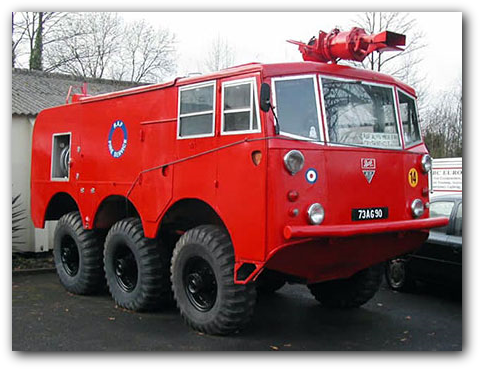
Next morning went to Movements ready for the flight back to UK. Surprise! - saw the load was a big red Mark 6 Firetender, and we were going to RAF Habbaniyah in Iraq.
What a load. All the loose on the top of the Fire engine had been removed together with the Foam nozzle, the tyres had been deflated to reduce the vehicle height, and only the minimum dunnage on the floor, quite a tight fit!
Off we went to Habbaniyah, did the download, hoping to go back to Cyprus. No chance, Ops say we have to take the aircraft to Muharraq in Bahrain and await further instructions. So a nightstop at Habbaniyah. If you have ever been there and heard that bird which chirps all night long with “de-da-dit” the lads there called it the Roger bird, because that is the morse code for Roger seemingly, don't know how true that is, or if it is still there. Anyway, didn't get much sleep, thanks to the bird.
Next morning , out to the aircraft and off to Muharraq, arrived ok, into Ops, “You are going back to the UK as passengers, when we find a flight…”
What a load. All the loose on the top of the Fire engine had been removed together with the Foam nozzle, the tyres had been deflated to reduce the vehicle height, and only the minimum dunnage on the floor, quite a tight fit!
Off we went to Habbaniyah, did the download, hoping to go back to Cyprus. No chance, Ops say we have to take the aircraft to Muharraq in Bahrain and await further instructions. So a nightstop at Habbaniyah. If you have ever been there and heard that bird which chirps all night long with “de-da-dit” the lads there called it the Roger bird, because that is the morse code for Roger seemingly, don't know how true that is, or if it is still there. Anyway, didn't get much sleep, thanks to the bird.
Next morning , out to the aircraft and off to Muharraq, arrived ok, into Ops, “You are going back to the UK as passengers, when we find a flight…”
Two days later, a Comet aircraft of 216 Sqdn arrives and we board that for our return to UK, great a VIP aircraft for us, coming home via Akrotiri, where we pick up the C-in-C for his flight back to RAF Colerne, where, we were flown back to Dishforth in a Valetta aircraft. Quite a trip, and not bad considering we were in blue uniform all the time, didn't have any KD with us, however, there wasn't much of a problem getting kit dry.
I am sorry I haven't any photgraphic evidence of the Mark 6 in the Beverley, but as you can imagine in those days we only had the trusty Brownie Box cameras, which of course I hadn't taken with me as I was only expecting to be on a short schedule. But we had trips like this in later years on UKMAMS, and it taught me to always have the extra kit with you.
Recently, I have been to Fort Paull near Hull which houses the last remaining Beverley in one piece in the Museum, quite a sight, the old bird.
I do remember that Tutankhamun incident with Dave Barton. Met him years later in Gatow, hadn't changed much. Have also been in contact with John Guy, seemingly we were at Akrotiri in Supply in 63/66. He went to Movements and was on the School at Abingdon and Brize.
Rgds, Arthur
I am sorry I haven't any photgraphic evidence of the Mark 6 in the Beverley, but as you can imagine in those days we only had the trusty Brownie Box cameras, which of course I hadn't taken with me as I was only expecting to be on a short schedule. But we had trips like this in later years on UKMAMS, and it taught me to always have the extra kit with you.
Recently, I have been to Fort Paull near Hull which houses the last remaining Beverley in one piece in the Museum, quite a sight, the old bird.
I do remember that Tutankhamun incident with Dave Barton. Met him years later in Gatow, hadn't changed much. Have also been in contact with John Guy, seemingly we were at Akrotiri in Supply in 63/66. He went to Movements and was on the School at Abingdon and Brize.
Rgds, Arthur
Royal Air Force’s A400M Atlas visits JASDF base for first time
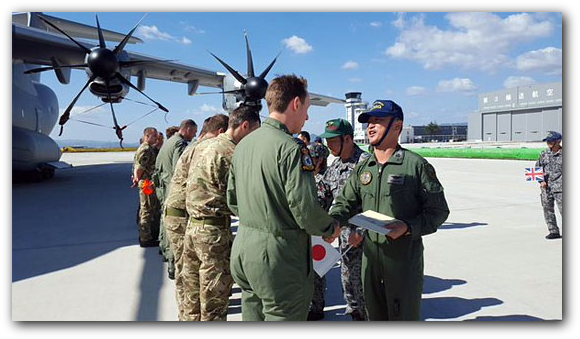
The UK Royal Air Force's (RAF) A400M Atlas transport aircraft has visited Japan, landing at Miho Base of the Japanese Air Self Defence Force (JASDF).
This latest development marks the first time landing of an RAF aircraft in a JASDF base and also the first A400M Atlas to fly to the Far East.
Along with the aircraft, crew from 70 Squadron and 24 Squadron based in RAF Brize Norton also met with counterparts in the JASDF 403 Squadron of the 3rd Tactical Airlift Wing.
Captain of the flight Squadron leader Stu Patton said: "I feel privileged to visit Japan. From start to finish, it has been a phenomenal experience. The crew had an excellent opportunity to learn about capabilities of JASDF aircraft and have been honoured by the hospitality offered by our hosts at Miho Airbase."
This latest development marks the first time landing of an RAF aircraft in a JASDF base and also the first A400M Atlas to fly to the Far East.
Along with the aircraft, crew from 70 Squadron and 24 Squadron based in RAF Brize Norton also met with counterparts in the JASDF 403 Squadron of the 3rd Tactical Airlift Wing.
Captain of the flight Squadron leader Stu Patton said: "I feel privileged to visit Japan. From start to finish, it has been a phenomenal experience. The crew had an excellent opportunity to learn about capabilities of JASDF aircraft and have been honoured by the hospitality offered by our hosts at Miho Airbase."
The JASDF and RAF crew exchanged opinions about their aircrafts during the stay at Miho Airbase.
Patton added: "We are in different parts of the world, but we share a similar culture as air transport officers. The crew had an excellent opportunity to learn about capabilities of JASDF aircraft and have been honoured by the hospitality offered by our hosts at Miho Airbase. I look forward to working even closer with Japanese colleagues as their new C-2 transport aircraft comes into service in the near future."
Before arriving in Japan, the A400M Atlas and its crew visited locations including Subang in Malaysia and Seoul for the Aerospace and Defence Exhibition.
The Airbus-built A400M is a multi-national military transport aircraft designed to serve as a tactical airlifter with strategic capabilities. It is powered by four EuroProp TP400-D6 turboprop engines.
The RAF received the seventh A400M aircraft from Airbus Defence and Space in September
airforce-technology.com
Patton added: "We are in different parts of the world, but we share a similar culture as air transport officers. The crew had an excellent opportunity to learn about capabilities of JASDF aircraft and have been honoured by the hospitality offered by our hosts at Miho Airbase. I look forward to working even closer with Japanese colleagues as their new C-2 transport aircraft comes into service in the near future."
Before arriving in Japan, the A400M Atlas and its crew visited locations including Subang in Malaysia and Seoul for the Aerospace and Defence Exhibition.
The Airbus-built A400M is a multi-national military transport aircraft designed to serve as a tactical airlifter with strategic capabilities. It is powered by four EuroProp TP400-D6 turboprop engines.
The RAF received the seventh A400M aircraft from Airbus Defence and Space in September
airforce-technology.com
The Rescue of the "Budding Rose" Crew
Budding Rose PD 284 and her crew along with RAF Lossiemouth`s Sea King helicopters and their crews became television stars as ITV broadcast the first programme in a documentary series about their round the clock search and rescue work.
The 13 part "Rescue" series began by highlighting an incident that must have struck close to home for viewers in the North - a fishing boat in distress.
The real life drama was filmed in 1988, when the seven man crew of the Peterhead fishing vessel "Budding Rose" had to be winched to safety after the vessel began taking water in gale-force conditions 100 miles east of Aberdeen.
An RAF Lossiemouth Sea King was scrambled - and the three hour rescue operation was filmed by award winning cameraman Paul Berriff, who lived and worked with the number 202 Squadron`s helicopter flight for a year to produce the series.
Watching helicopter winchman [OBA Member] Bob Pountney being lowered to the deck of the heaving vessel - which was being buffeted by 40ft waves - made for compelling viewing as the pilot, Flt Lt. John Prince, stated calmly over the intercom: " There is no hurry, no one is going to be injured on this one, so no heroics".
The 13 part "Rescue" series began by highlighting an incident that must have struck close to home for viewers in the North - a fishing boat in distress.
The real life drama was filmed in 1988, when the seven man crew of the Peterhead fishing vessel "Budding Rose" had to be winched to safety after the vessel began taking water in gale-force conditions 100 miles east of Aberdeen.
An RAF Lossiemouth Sea King was scrambled - and the three hour rescue operation was filmed by award winning cameraman Paul Berriff, who lived and worked with the number 202 Squadron`s helicopter flight for a year to produce the series.
Watching helicopter winchman [OBA Member] Bob Pountney being lowered to the deck of the heaving vessel - which was being buffeted by 40ft waves - made for compelling viewing as the pilot, Flt Lt. John Prince, stated calmly over the intercom: " There is no hurry, no one is going to be injured on this one, so no heroics".
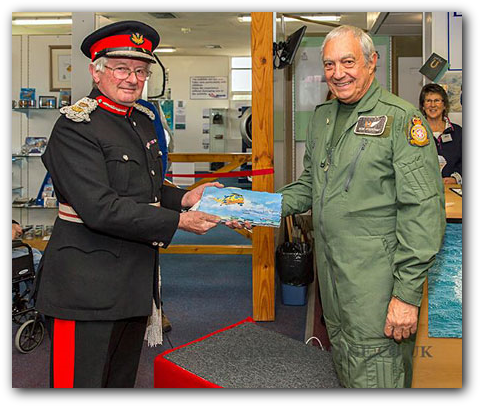
The faces of the Budding Rose crew told the story better than any words as they were winched to safety in the helicopter. Four hours later - and still more than 100 miles from dry land - the Budding Rose sank.
Twins Peter and Stephen along with the crew of the Budding Rose, highly commended the acts of the helicopter crew on the day of their rescue and will never forget their deeds.
Twins Peter and Stephen along with the crew of the Budding Rose, highly commended the acts of the helicopter crew on the day of their rescue and will never forget their deeds.
Scottish Television
From: David Powell, Princes Risborough
Sent: 26 October 2015 14:33
Subject: Re: Exotic or Strange Loads
Hi Tony,
Probably my most valuable load was the prototype intakes for Concord 002, from Filton to the Concord assembly plant at Toulouse by Beverley.
Remarkable for the offload when up clattered a battered old Renault lorry with springs which gave just by leaning on the flat floor, and the offload team of 4 Gauloise-puffing labourers armed with crowbars.
Visions of mega bucks of R&D investment (and my career) disappearing in a heap of remodelled titanium sheet! However, job done - but that's another story! The back load was via Tours to collect a Spitfire.
Sent: 26 October 2015 14:33
Subject: Re: Exotic or Strange Loads
Hi Tony,
Probably my most valuable load was the prototype intakes for Concord 002, from Filton to the Concord assembly plant at Toulouse by Beverley.
Remarkable for the offload when up clattered a battered old Renault lorry with springs which gave just by leaning on the flat floor, and the offload team of 4 Gauloise-puffing labourers armed with crowbars.
Visions of mega bucks of R&D investment (and my career) disappearing in a heap of remodelled titanium sheet! However, job done - but that's another story! The back load was via Tours to collect a Spitfire.
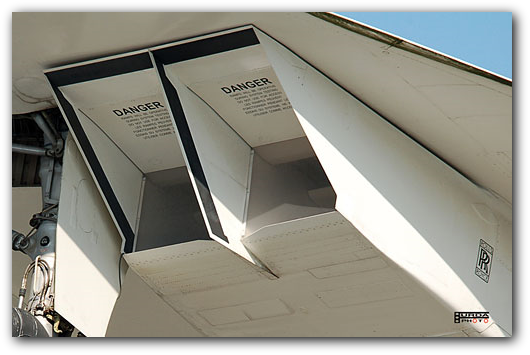
Another ‘unusual’ was a very large box containing a rather fragile landscape model of Tromso Fjord that had been used for planning the 617 Sqn attack on Tirpitz. This we took from Abingdon to Gardermoen (Oslo), again by Beverley.
But, my entry for the ‘most original’ would have to be a Gulf MAMS task solving the problem of ‘how do you move a working telephone exchange from RAF Sharjah to Hong Kong in just one Herc?’ The solution was to wrap the complete relay racks in polythene, and build pallets next to the 'about to be demolished' exchange (which now had a large hole in one wall) by making layer cakes of racks separated by mattresses (from the about to be demolished airmen’s accommodation), plus one pallet for the odd boxes of ‘make it work’ stuff.
Forklift the pallets direct to Herc, lock in and reverse the procedure at the other end. Obviously such a high-tech task required the deployment of a competent qualified Gulf MAMS team who then had to spend nearly a week at Kai Tak waiting for a ride back to Sharjah, where we were based for our last few weeks in the Gulf.
Happy memories of what we got away with before they invented real times comms and video links!
David Powell
F Team UK MAMS 1967-69
Last Gulf MAMS 1971.
But, my entry for the ‘most original’ would have to be a Gulf MAMS task solving the problem of ‘how do you move a working telephone exchange from RAF Sharjah to Hong Kong in just one Herc?’ The solution was to wrap the complete relay racks in polythene, and build pallets next to the 'about to be demolished' exchange (which now had a large hole in one wall) by making layer cakes of racks separated by mattresses (from the about to be demolished airmen’s accommodation), plus one pallet for the odd boxes of ‘make it work’ stuff.
Forklift the pallets direct to Herc, lock in and reverse the procedure at the other end. Obviously such a high-tech task required the deployment of a competent qualified Gulf MAMS team who then had to spend nearly a week at Kai Tak waiting for a ride back to Sharjah, where we were based for our last few weeks in the Gulf.
Happy memories of what we got away with before they invented real times comms and video links!
David Powell
F Team UK MAMS 1967-69
Last Gulf MAMS 1971.
Vulcan XH558 - Cold War Bomber Takes to the Skies for Final Time
The only remaining flying Vulcan bomber has flown for the last time. The huge Vulcan XH558 Cold War bomber - which once carried Britain's nuclear deterrent - took off from Doncaster Robin Hood Airport for a short final trip after the gloomy South Yorkshire skies cleared on Wednesday 28th October 2015.
The pilot, Martin Withers, led the first of the now legendary raids on the Falklands by the Vulcans in 1982 - the only time the aircraft ever dropped bombs in anger in its long RAF service.
As he prepared for the flight, Mr Withers said: "Everyone asks me what is so special about this aircraft and why people love it. Really the people who fly it are the wrong people to ask. It's such a combination of grace and beauty of just seeing this thing fly.
The pilot, Martin Withers, led the first of the now legendary raids on the Falklands by the Vulcans in 1982 - the only time the aircraft ever dropped bombs in anger in its long RAF service.
As he prepared for the flight, Mr Withers said: "Everyone asks me what is so special about this aircraft and why people love it. Really the people who fly it are the wrong people to ask. It's such a combination of grace and beauty of just seeing this thing fly.
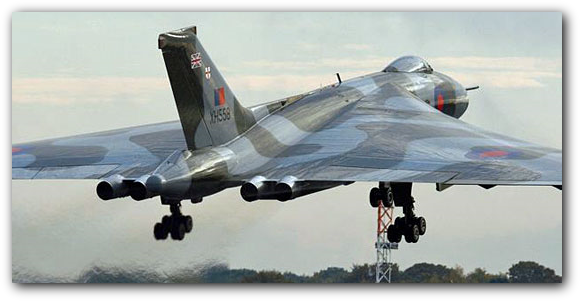
"Just to see it fly along, it's so graceful. And then that combines with the sense of power and manoeuvrability you've got with this aircraft and the vibrations it makes. It just seems to turn people on emotionally, they really love it."
Former pilot Angus Laird said: "I think it's very, very sad but we all come to a time when we stop flying. She's an old lady now and she's stopped at the height of her popularity, which I think is brilliant."
The XH558, which first came into RAF service in 1960, has been kept in the air by a volunteer trust since 2007. This summer, millions of people have watched it as it has made a farewell tour of the UK before its permit-to-fly expires at the end of October.
Former pilot Angus Laird said: "I think it's very, very sad but we all come to a time when we stop flying. She's an old lady now and she's stopped at the height of her popularity, which I think is brilliant."
The XH558, which first came into RAF service in 1960, has been kept in the air by a volunteer trust since 2007. This summer, millions of people have watched it as it has made a farewell tour of the UK before its permit-to-fly expires at the end of October.
The Vulcan To The Sky Trust, which brought the 55-year-old aircraft back to flight eight years ago, has accepted advice from supporting companies that they no longer have the expertise to keep it airworthy as engineers retire from the industry.
XH558 will stay in its Cold War hanger at Robin Hood Airport - once RAF Finningley - where the trust is planning a visitor centre and also to continue "fast taxiing" the massive bomber around the runways.
The trust had to keep details of Wednesday's final flight under wraps until the last minute as the aircraft has become such a popular attraction. Airport officials feared news of the event could attract thousands of spectators, endangering its normal operations.
John Sharman, chairman of the trust, said: "It's a sad day but its also a day of optimism in many ways. Today marks the end of the beginning of this life of Vulcans because we have huge plans for the future. We will preserve this aeroplane for the nation in working order, if not in flying order, for the future as the centrepiece of a heritage centre."
Mr Sharman said: "She is very beautiful, she is very powerful, she is is totally unique, totally distinct. And that delta shape seems to inspire both young and old."
Huddersfield Daily Examiner
XH558 will stay in its Cold War hanger at Robin Hood Airport - once RAF Finningley - where the trust is planning a visitor centre and also to continue "fast taxiing" the massive bomber around the runways.
The trust had to keep details of Wednesday's final flight under wraps until the last minute as the aircraft has become such a popular attraction. Airport officials feared news of the event could attract thousands of spectators, endangering its normal operations.
John Sharman, chairman of the trust, said: "It's a sad day but its also a day of optimism in many ways. Today marks the end of the beginning of this life of Vulcans because we have huge plans for the future. We will preserve this aeroplane for the nation in working order, if not in flying order, for the future as the centrepiece of a heritage centre."
Mr Sharman said: "She is very beautiful, she is very powerful, she is is totally unique, totally distinct. And that delta shape seems to inspire both young and old."
Huddersfield Daily Examiner
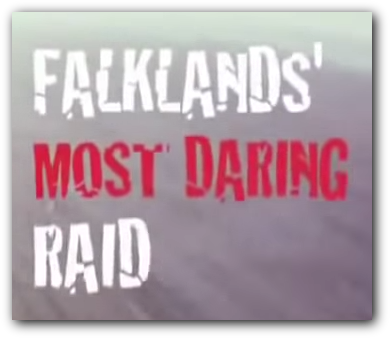
This gripping film tells the humorous yet heroic story of how a crumbling, Cold-War era Vulcan flew the then longest range bombing mission in history and how a WW2 vintage bomb changed the outcome of the Falklands War.
On 30th April 1982, the RAF launched a secret mission; to bomb Port Stanley's runway, putting it out of action for Argentine fighter jets.
The safety of the British Task Force depended on its success. But the RAF could only get a single Vulcan 8,000 miles south to the Falklands as just one bomber needed an aerial fleet of thirteen Victor tanker planes to refuel it throughout the 16 hour round-trip.
From start to finish, the seemingly impossible mission was a comedy of errors, held together by sheer British pluck and ingenuity. On the brink of being scrapped, only three of the ageing nuclear bombers could be fitted out for war, one to fly the mission and two in reserve.
On 30th April 1982, the RAF launched a secret mission; to bomb Port Stanley's runway, putting it out of action for Argentine fighter jets.
The safety of the British Task Force depended on its success. But the RAF could only get a single Vulcan 8,000 miles south to the Falklands as just one bomber needed an aerial fleet of thirteen Victor tanker planes to refuel it throughout the 16 hour round-trip.
From start to finish, the seemingly impossible mission was a comedy of errors, held together by sheer British pluck and ingenuity. On the brink of being scrapped, only three of the ageing nuclear bombers could be fitted out for war, one to fly the mission and two in reserve.
Crucial spare parts were scavenged from museums and scrap yards - one vital piece found as an ashtray in the Officer's Mess. In just three weeks, the Vulcan crews had to learn air-to-air refuelling, which they hadn't done for twenty years and conventional bombing, which they hadn't done for ten.
The RAF scoured the country for old WW2 iron bombs and complex refuelling calculations were done the night before on a £5 pocket calculator.
With a plan stretched to the limit and the RAF's hopes riding on just one Vulcan, the mission was flown on a knife-edge; fraught with mechanical failures, unreliable navigation, electrical storms and ultimately not enough fuel. Of the Vulcan's twenty-one bombs dropped, only one found its target. But that was enough to change the outcome of the war.
The RAF scoured the country for old WW2 iron bombs and complex refuelling calculations were done the night before on a £5 pocket calculator.
With a plan stretched to the limit and the RAF's hopes riding on just one Vulcan, the mission was flown on a knife-edge; fraught with mechanical failures, unreliable navigation, electrical storms and ultimately not enough fuel. Of the Vulcan's twenty-one bombs dropped, only one found its target. But that was enough to change the outcome of the war.
From: Chris Kirby, Bourg St Maurice
Sent: 28 October 2015 3:21
Subject: Exotic or Strange Loads
Hi Tony,
On 17 Aug 1987 Rudolph Hess was found dead at Spandau prison in Berlin. Hess (Hitlers' deputy from 1933 to 1941) was the sole remaining prisoner at the 600 cell jail, which was jointly guarded in rotation by the UK, United States, France, and the (then) Soviet Union.
Hess was 93 years old and there was a long established repatriation contingency plan in place for the event of his death, which was declared as suicide. I assume it was the UKs' turn on guard at Spandau as we picked up the job. A Herc, a crew, and a half MAMS team (Ken Morris, Mal 'the general' Paton, & myself) team were quickly generated and we got airborne for RAF Gatow, there to await developments whilst an investigation, autopsy, and other formalities took place.
All this took a couple of days or so. The Berlin Wall was still up at that time, so we managed to fit in some touristy sightseeing: such as Check Point Charlie / location of Hitlers' final bunker / and the Wall itself. I also recall being introduced to some very potent lemon vodka (marvellous stuff !) by Steve & Jo Duke who were then stationed at Gatow.
In due course the coffin was delivered to us at the Herc by the undertakers & various government reps, all of whom then withdrew. We did our Mover bit as regards prepping & securing the load etc., and we went wheels up for an obscure USAF base down near Munich. This destination (an A10 Thunderbolt FOB) was chosen as it was close to the secret location where Hess was initially buried. Secret because the authorities wanted to try and avoid too much media attention and the potential for trouble from both neo-Nazi supporters and demonstrators.
Sent: 28 October 2015 3:21
Subject: Exotic or Strange Loads
Hi Tony,
On 17 Aug 1987 Rudolph Hess was found dead at Spandau prison in Berlin. Hess (Hitlers' deputy from 1933 to 1941) was the sole remaining prisoner at the 600 cell jail, which was jointly guarded in rotation by the UK, United States, France, and the (then) Soviet Union.
Hess was 93 years old and there was a long established repatriation contingency plan in place for the event of his death, which was declared as suicide. I assume it was the UKs' turn on guard at Spandau as we picked up the job. A Herc, a crew, and a half MAMS team (Ken Morris, Mal 'the general' Paton, & myself) team were quickly generated and we got airborne for RAF Gatow, there to await developments whilst an investigation, autopsy, and other formalities took place.
All this took a couple of days or so. The Berlin Wall was still up at that time, so we managed to fit in some touristy sightseeing: such as Check Point Charlie / location of Hitlers' final bunker / and the Wall itself. I also recall being introduced to some very potent lemon vodka (marvellous stuff !) by Steve & Jo Duke who were then stationed at Gatow.
In due course the coffin was delivered to us at the Herc by the undertakers & various government reps, all of whom then withdrew. We did our Mover bit as regards prepping & securing the load etc., and we went wheels up for an obscure USAF base down near Munich. This destination (an A10 Thunderbolt FOB) was chosen as it was close to the secret location where Hess was initially buried. Secret because the authorities wanted to try and avoid too much media attention and the potential for trouble from both neo-Nazi supporters and demonstrators.
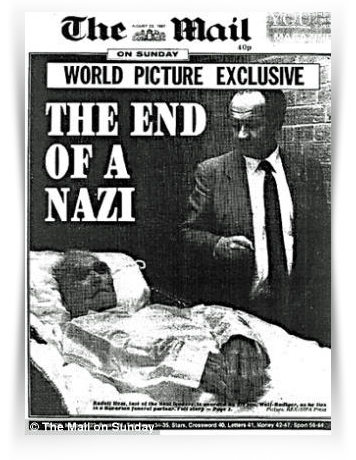
As repatriations go (other than whom we were carrying) it was a pretty straightforward task & we soon returned to Lyneham to update our logbooks.
But there were some interesting postscripts to the story. To this day rumours continue to circulate as regards whether Hess' death really was suicide. One report suggests that the note found on his body dated back to a hospital visit in 1969. And another report claims that Hess was too old & frail to have committed suicide in the way he did (apparently by hanging himself using an electrical extension cord). At various times during his incarceration after the Nuremberg trials Hess himself claimed his food was being poisoned. Spandau prison was demolished to prevent it becoming a 'shrine'. In 1988 Hess was re-interred at the family plot in Wunsiedel (Bavaria). But this grave did indeed become subject to annual pilgrimmages and demonstrations. Therefore - in 2011 - Hess' remains were again exhumed, then cremated and scattered at sea by his descendants.
(Hope the last bit wasn't too grisly for you !)
Happy lashing.
Rip Kirby
But there were some interesting postscripts to the story. To this day rumours continue to circulate as regards whether Hess' death really was suicide. One report suggests that the note found on his body dated back to a hospital visit in 1969. And another report claims that Hess was too old & frail to have committed suicide in the way he did (apparently by hanging himself using an electrical extension cord). At various times during his incarceration after the Nuremberg trials Hess himself claimed his food was being poisoned. Spandau prison was demolished to prevent it becoming a 'shrine'. In 1988 Hess was re-interred at the family plot in Wunsiedel (Bavaria). But this grave did indeed become subject to annual pilgrimmages and demonstrations. Therefore - in 2011 - Hess' remains were again exhumed, then cremated and scattered at sea by his descendants.
(Hope the last bit wasn't too grisly for you !)
Happy lashing.
Rip Kirby
From: Harold Jones, Neston, Cheshire
Sent: 28 October 2015 16:20
Subject: Funeral of Peter Spear 28/10/2015
Tony,
Sent: 28 October 2015 16:20
Subject: Funeral of Peter Spear 28/10/2015
Tony,
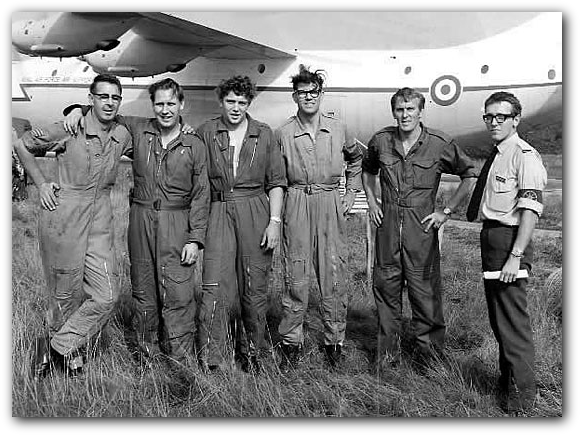
Denmark, September 1969. Left to right: Tony Pyne, Pete Spear,
Alan (Boot) Pratt, John Evans, Jack Worrell and David (Dizzy) Benson
Alan (Boot) Pratt, John Evans, Jack Worrell and David (Dizzy) Benson
I had the privilege of attending Peter's funeral in Wetherby, it was well attended by a wide spectrum of Peter's family and friends.
The Padre conducting the service was an old next door neighbour, the neighbours from the other side were also there. This was so typical of Peter who always seemed to make friends where ever he was.
The service brought out the Peter we all knew, dry humour, a touch of wickedness and a care for others.
At the booze up (reception) afterwards I spoke to an old school friend, his cousin and other friends and relations, they all had the same warm memories of Peter.
Both Dorothy (Lady Dorothy as he always called her) and his son-in-law Peter were very touched that he was remembered by us after so many years. His fondness for his time on UKMAMS was also mentioned during the service.
A fitting farewell to Peter Spear. May he rest in peace.
The Padre conducting the service was an old next door neighbour, the neighbours from the other side were also there. This was so typical of Peter who always seemed to make friends where ever he was.
The service brought out the Peter we all knew, dry humour, a touch of wickedness and a care for others.
At the booze up (reception) afterwards I spoke to an old school friend, his cousin and other friends and relations, they all had the same warm memories of Peter.
Both Dorothy (Lady Dorothy as he always called her) and his son-in-law Peter were very touched that he was remembered by us after so many years. His fondness for his time on UKMAMS was also mentioned during the service.
A fitting farewell to Peter Spear. May he rest in peace.
I was pleased that I was able to attend and to represent the Old Bods Association.
Harold Jones
Harold Jones
This newsletter is dedicated
to the memories of:
Ivan & Wilma Gervais
Sir Michael Beetham
John O'Regan
David Howley
Peter Spear
to the memories of:
Ivan & Wilma Gervais
Sir Michael Beetham
John O'Regan
David Howley
Peter Spear
Please support the OBA





